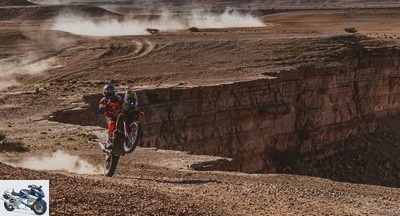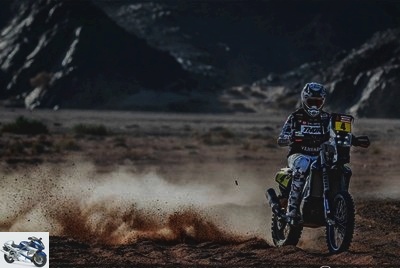Airbag and restrained motorcycles on the next Dakar rally-raid

The International Motorcycling Federation (FIM) is planning several measures to reduce accidents in the Dakar and in rally-raid in general: restrict the air intake of the engines, improve the road books and generalize the airbag, in particular. Explanations.
The 2020 was unfortunately again mourned by two deaths on motorcycles: the Portuguese and the Dutch, respectively the 20th and 21st bikers who died on the "King of the Rallies" … To these tragic disappearances are also added several big eliminatory crashes, including those of Adrien Van Beveren (Yamaha) and Sam Sunderland (KTM).
- MNC of January 24, 2020:
- MNC of January 12, 2020 :
- MNC special file :
Among the causes of these accidents are the extremely high average speeds of this first edition in Saudi Arabia, with stages negotiated at more than 120 km / h on average! Bikers have also had to deal with the difficulty of finding new terrain in the vast expanses of desert in the Middle East..
The International Motorcycling Federation (FIM) has therefore decided to bring together the rally-raid organizers – including the ASO, which oversees the Dakar – as well as pilots and manufacturers with a view to defining new strategies to improve safety. of all, competitors as spectators.
Objectives: "to reduce the number of accidents involving both the drivers and the public, and increase safety in all rally events, with particular emphasis on the Dakar", explains the FIM, which has identified several factors of risks including fatigue, excessive speed, accuracy of the road book and navigation errors, very frequent during the last edition.
Reviewed routes, more precise road book and airbag
After having consulted the opinion of all the parties, the federation proposes various measures to tend towards more safety such as for example to trace "all the routes of the FIM championships in collaboration with a former motorcycle rider". Variations in course styles will also be provided to reduce average speed.

In addition, a "team of inspectors" will be appointed to produce the road book so that drivers and teams "have the same level of information and a more faithful interpretation of the real level of difficulty of the course", announces the FIM, which develops in parallel, a new instrumentation platform with more "visual and sound" alerts.
Finally, two key measures will come into force in the short term: the first concerns the adoption of airbags "as soon as possible" for motorcyclists, on the model in particular of the MotoGP where all the pilots wear an electronic airbag with autonomous triggering (without wired connection or sensors on the motorcycle).
- MNC file :
"An imminent meeting is planned with the manufacturers concerned, 2020 being used for development with a view to implementation in 2021", predicts the federation, which will have to select a particularly advanced device in terms of ventilation to avoid " hot shots "during long stages under the scorching Saudi Arabian sun !
Throttled engines on the Dakar 2021
On the other hand, the next edition of the Dakar will be contested on motorcycles clamped via "air intake restrictors as in the WSBK 300 world championship", with the aim of "reducing the engine power and also reducing the speed ", warns the FIM, which announces that a" test period will apply until June ".

This flange system refers to the 2010 edition of the Dakar, when the limitation of the displacement of motorcycles to 450 cc came into force: non-elite riders could then continue to use single cylinders of higher displacement – up to 690 cc at KTM -, provided they restrict their air intake.
- MNC of June 3, 2009 : The Dakar is limited to 450 cc to revive its interest
This measure is aimed directly at the flagship rally-raid manufacturers who have managed to extract impressive power from their engine, while ensuring the reliability necessary to cover the 9,000 km of a Dakar. Honda speeds regularly exceed 180 km / h, as do powerful KTMs. !
"I am satisfied with this very constructive meeting intended to try to reduce the number of accidents in rallying, a priority for the FIM in particular on the Dakar", comments the President of the FIM, Jorge Viegas. "We will test the solutions from the start of this season and we will take stock at the end of the season to adjust as needed".
"The participation of ASO, KTM, Husqvarna, Hero, Honda, Yamaha as well as riders Sam Sunderland and Adrien Van Beveren has enabled us to work hand in hand to meet this challenge in order to ensure the sustainability of this spectacular and unique championship" , he concludes with optimism.
Related articles
-
Dakar – Motorcycle rally-raid: the 2013 Dakar is full of participants –
Motorcycle rally-raid: the 2013 Dakar fills up with participants The organizer of the Dakar, Amaury Sport Organization (ASO), can have a smile: the lists…
-
Dakar – Julien Toniutti at the 2019 Dakar motorcycle: from road rally to rally-raid! –
Julien Toniutti at the Dakar motorcycle 2019: from road rally to rally-raid ! First quality required for a motorcycle rally driver on the road:…
-
Dakar – Rally-raid: Julien Toniutti selected for the 2019 Dakar motorcycle! –
Rally-raid: Julien Toniutti selected for the Dakar motorcycle 2019 ! Julien Toniutti, quadruple champion of France in motorcycle road rallies, ticks the…
-
Dakar – Motorcycle rally-raid: it won’t be Peru for the Dakar 2016 either … –
Motorcycle rally-raid: it won’t be Peru for the Dakar 2016 either… Things are getting seriously complicated for the organizers of the Dakar 2016:…
-
Dakar – Motorcycle rally-raid: the Dakar 2016 embarks for Argentina –
Motorcycle rally-raid: the Dakar 2016 embarks for Argentina The 256 European vehicles entered on the Dakar 2016 – out of a total of 354 scheduled for…
-
Dakar – Rally-raid: who are the favorites of the Dakar motorcycle 2016 –
Rally-raid: who are the favorites of the Dakar motorcycle 2016 A few days before the start of the 38th Dakar, the bikers are doing their final checks in…
-
All-terrain – Motorcycle rally-raid: Honda back on the Dakar – Used HONDA
Motorcycle rally-raid: Honda back on the Dakar Honda will officially participate in the 2013 Dakar rally, which will cross South America from January 5….
-
Dakar – Rally-raid: 70 Yamaha riders in the Dakar 2013 –
Rally-raid: 70 Yamaha riders in Dakar 2013 On Saturday January 5, the Dakar will start from Lima (Peru) for a fortnight of racing to Santiago (Chile)….
-
Dakar – Motorcycle rally-raid: the final route of the Dakar 2016 –
Motorcycle rally-raid: the definitive route of the Dakar 2016 This time it’s the right one! Only 3 and a half months before the start in Buenos Aires…
-
Dakar – Motorcycle rally-raid: Coma hangs up and becomes Dakar sports director –
Motorcycle rally -raid: Coma hangs up and becomes Dakar sports director From “motorcycle pilot” to the Dakar, the defending champion Marc Coma (38)…